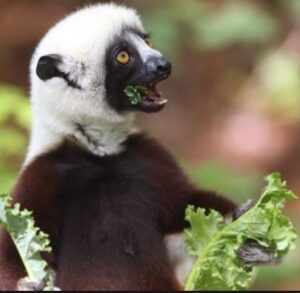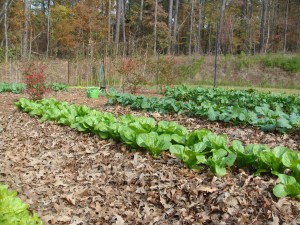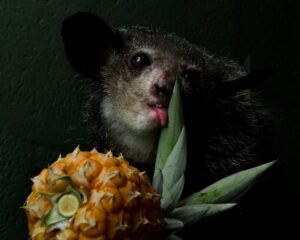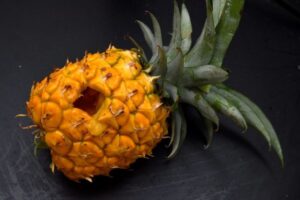Greens for Lemurs at the DLC
During the spring, summer, and fall, the lemurs living at the Duke Lemur Center can be found feeding on leaves, fruits, seeds, and acorns in the one hundred acres of forest they call home. But in order to make sure every animal is getting both the amount and kind of food they need daily, all DLC residents receive an individualized diet. Over two hundred mouths to feed at least twice a day adds up (even if those mouths belong to a tiny mouse lemur)!
Lemurs at the DLC consume an average of 25 pounds of fruits and veggies per day. Most of this organic produce is sourced from a restaurant supply company and arrives by the truckload about once a week. Because lemur species are so diverse, they require a wide range of fruits, vegetables, and proteins to remain healthy. Most lemurs will eat everything from coconut to cabbage to kiwis, but greens are one of the most important staples for our leaf-eating lemurs.

A Coquerel’s sifaka enjoys fresh kale from the DLC gardens as part of a healthy breakfast!
In 2010, the DLC received a grant from the Mary Duke Biddle Foundation to start a vegetable garden that would help supplement the lemurs’ diets. Charlie Welch, conservation coordinator and gardener extraordinaire, headed up the project with the help of garden manager Amanda Wilkins, a NC State horticultural science graduate. The two of them set to work planning a garden space behind the DLC’s nocturnal building, a former construction site. According to Charlie, the ground was in pretty bad shape, and it took a lot of TLC (and compost) to get the soil back to a usable condition. With the help of dedicated volunteers, the garden has gone from a patch of compacted clay to a fruitful and flourishing patch of Eden on the DLC’s grounds.

A pair of mongoose lemurs crunch down on celery stalks.
The garden is designed to be as sustainable as possible, using a chemical-free insect control system, reclaimed rainwater, and plenty of healthy compost from the DLC kitchens. Water runoff from the roof of the nocturnal building is collected in 1000-gallon water tanks and runs down to the garden through a hose, keeping it watered even during the hottest months of the year. Three vermicomposting bins produce nutrient-rich humous, and a companion-planting system helps keep insects at bay. Organic vegetables and greens are grown from seed, and all weeding, watering, and harvesting is done by hand—mostly by Charlie and a dedicated group of volunteers.

The DLC garden filled with leafy greens ready to be picked, washed, and distributed to the lemurs.
Because there is so much native wildlife also using the DLC’s hundred-acre wood, not many large fruits and vegetables are produced in the garden, as they are too frequently scavenged by locals. Greens are the primary output of the garden, as they can be grown year-round. In recent years, 200-300 pounds of kale, collards, chards, arugula, and numerous varieties of lettuce have been harvested from the garden annually. That’s a lot of salad! Outside of the garden, Charlie has attempted to bring a taste of home to the Madagascar-native lemurs. Pineapple plants, vanilla, coffee, cocoa, banana, and papaya trees are also found around DLC property, thanks to Charlie’s ministrations. Though the output of these is not robust enough to serve as a food source for the lemurs, there is still the occasional success.

Lucrezia licks honey off the pineapple leaves.
Pineapple bushes take 2-3 years to fruit, but it’s arguably worth the wait. One ripe, delicious pineapple harvested from DLC grounds was offered to 17-year-old aye-aye Lucrezia. Because aye-ayes are rarely offered something as large as a whole pineapple, it was unclear whether Lucrezia would recognize her gift as something to eat, so her primary keeper Brittany spread honey on the leaves to encourage inspection. Lucrezia spent so much time enjoying the pineapple leaves that the staff had to leave for the day, hopeful that Lucrezia would enjoy her pineapple as a midnight snack. But when they returned in the morning, the pineapple appeared to be still intact, which felt like a bit anticlimactic. When they reached down to pick up the apparently untouched pineapple, they were surprised to find it considerably lighter than the day before. On further inspection, the staff found that Lucrezia had in fact hollowed out the pineapple using her long, dexterous tapping finger!

The single hole Lucrezia created in the pineapple and from which she scooped out the yummy insides.
While Lucrezia’s clear enjoyment of the pineapple was rewarding enough, the benefits of the DLC vegetable garden are much more impactful than one very happy aye-aye. The bountiful harvests from the garden have provided fresh, organic greens to the lemurs at little to no cost to the center, saving money and resources. The additional variety of greens and produce is beneficial to the animals, and allows them to “eat local,” which cuts down on the ecological impact of transporting vegetables and greens to the DLC. All around, the DLC Garden is as green as it gets!

